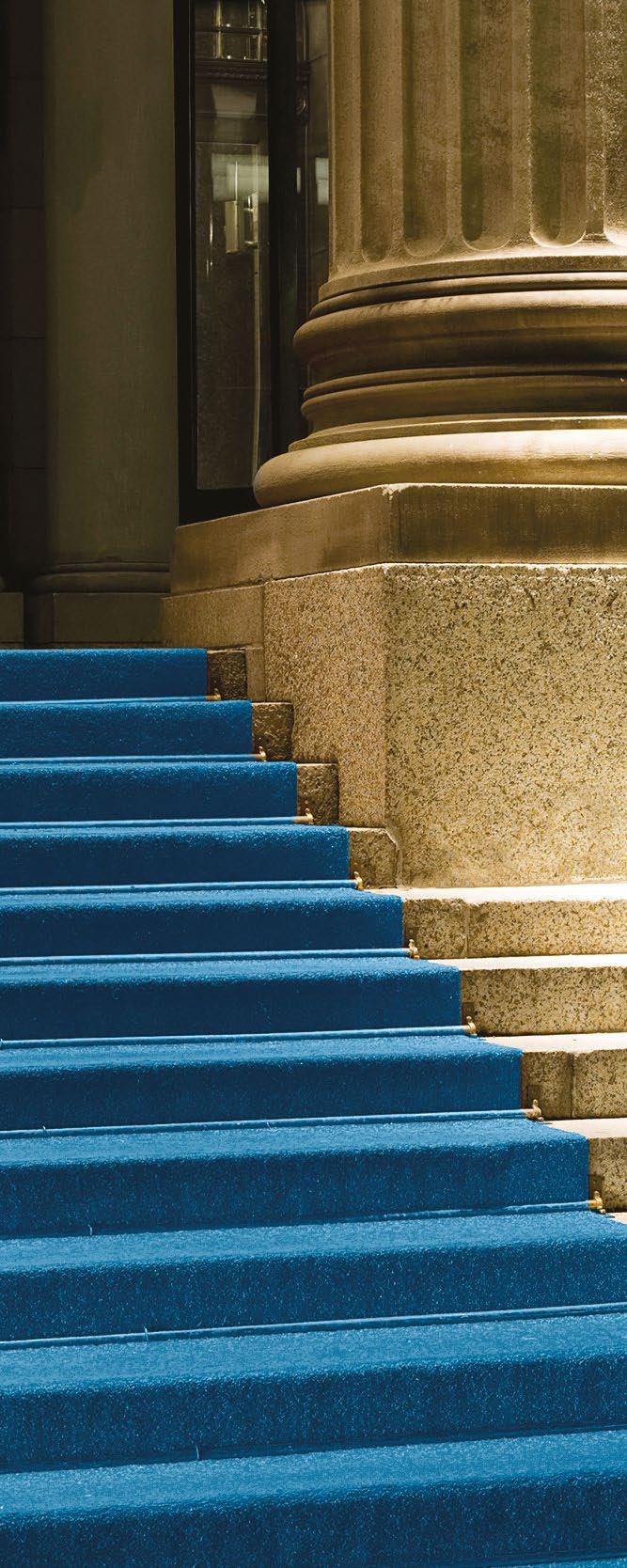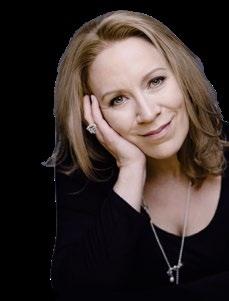


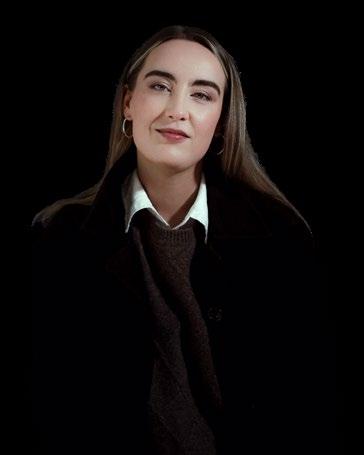
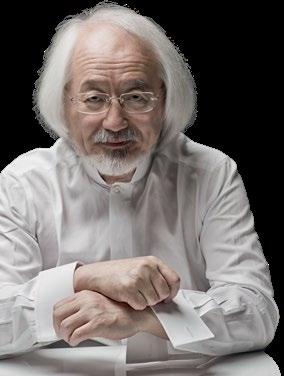




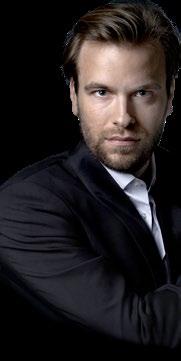











Monteverdi Choir
English Baroque Soloists
Masaaki Suzuki – conductor
Thursday 19 June 2025
St Martin-in-the-Fields
London
Scan the QR code or visit: www.monteverdi.co.uk/pages/newsletter
Thursday 19 June 2025, 7.30pm
St Martin-in-the-Fields, London
Monteverdi Choir & Orchestras presents
Monteverdi Choir
English Baroque Soloists
Masaaki Suzuki – conductor
Carolyn Sampson – soprano
Rebecca Leggett – mezzo-soprano
Guy Cutting – tenor
Matthias Winckhler – bass
from the MCO Team
Three hundred years ago the construction of the magnificent church in which you are sitting was nearing completion. And as St Martin-in-the-Fields (now the Monteverdi Choir & Orchestras’ London home) was taking shape, Johann Sebastian Bach was himself building something lasting and significant: in his role as Thomaskantor in Leipzig he was harnessing his extraordinary work ethic to produce an astonishing second cycle of cantatas – entirely original musical material shaped into 40 brand new cantatas, providing music for every Sunday and feast day in the liturgical calendar.
Tonight we bring you a selection of these 1725 cantatas, breathing new life into these exceptional works with the first outing of an electrifying combination: the renowned Bach specialist Masaaki Suzuki with the Monteverdi Choir and English Baroque Soloists. This group of musicians has, in the words of tonight’s conductor, “helped to shape the world’s understanding of this music for decades”, combining the latest Bach scholarship with vivid and compelling performances.
MCO has an unparalleled recorded legacy, but on record there is a crucial missing element: it is you, the audience, who elevate a performance into a sublime communal experience. As Suzuki puts it, “music only really exists in the moment of performance, otherwise it dissolves, disappears. Our job and responsibility is to keep the music alive.”
BACH Wie schön leuchtet der Morgenstern, BWV 1
BACH Herr Jesu Christ, wahr’ Mensch und Gott, BWV 127
interval
BACH ‘Sinfonia’ from Am Abend aber desselbigen Sabbats, BWV 42
BACH Ihr werdet weinen und heulen, BWV 103
BACH Gottlob! nun geht das Jahr zu Ende, BWV 28

MASAAKI SUZUKI CONDUCTS BACH
Scan to listen on Spotify

Dr Andrew Frampton
Dr Andrew Frampton
At the beginning of the year 1725, the Leipzig Thomaskantor Johann Sebastian Bach was just over halfway through work on what was rapidly becoming his most ambitious musical project. Six months earlier, in June 1724, he had completed his first annual cycle (Jahrgang) of cantatas for the Leipzig churches, and immediately proceeded to begin another. For his second Jahrgang, possibly to mark the bicentennial of the first Lutheran hymnal, Bach set out to compose a series of cantatas for almost every Sunday and feast day of the church year based entirely around Lutheran hymn tunes, or chorales. The chorale cantata cycle, as it became known, represents the most concentrated period of original composition in Bach’s life, a staggering feat of artistic productivity.
In order to meet the formal requirements of church music at the time, Bach developed an ingenious structural model for his chorale cantatas that ensured both unity and variety. The first movement is typically a ‘chorale fantasia’, where the chorale melody, its text unchanged, appears in long notes (most often in the soprano), in counterpoint with elaborate vocal polyphony and instrumental writing. A flexible sequence of arias and recitatives then sets free poetic paraphrases of the chorale text, before the cantata concludes with a plain four-part harmonisation of the chorale’s last verse.
There is almost no better example of this than Wie schön leuchtet der Morgenstern (‘How beautifully gleams the morning star’), BWV 1, composed for the Feast of the Annunciation. Its jubilant opening chorus (No. 1) is richly scored for horns, oboes da caccia and strings (including two concertante violins) in a ceremonial 12/8 time signature, and begins with a gentle melody in the second solo violin that is answered by the rest of the orchestra. The lively figuration of the two solo violins, depicting the sparkling of the Morning Star, gives the movement a distinctive sound, to which the choir is then added. As the lower voices dance around each other, they also support the entries of the sopranos, which rise above the rest of the ensemble singing the chorale melody (doubled by the first horn), creating an aural tableau of great splendour.
After a tenor recitative (No. 2), more symbolism appears in the first solo aria (No. 3), in which the intricate figuration of both the soprano and solo oboe da caccia—an unusual pairing in Bach’s cantatas—represents the flickering of the ‘göttlichen Flammen’ (‘divine flames’). In the recitative for bass that follows (No. 4), meanwhile, special emphasis is given to the words ‘Freudenschein’ (‘joyous ray’) and ‘Erquickung’ (‘delight’), before dancing rhythms return in the joyful triple-time tenor aria (No. 5). Appropriately for a text concerning the ‘Ton der Saiten’, it is scored for strings
only, and the return of the two solo violins from the first movement gives Bach the opportunity to employ delightful echo effects.
The festive orchestration of the opening movement reappears in the final chorale (No. 6). Just as the text calls for the arrival of the ‘schöne Freudenkrone’ (‘lovely crown of joy’), so too is the musical setting crowned by the burnished timbre of the horns, including a brilliant descant for the second horn part. Bach’s magisterial four-part harmonisation fully conveys the radiance of Philipp Nicolai’s well-known hymn; small wonder, then, that the editors of the first complete edition of Bach’s music in 1851 chose to inaugurate it with this cantata.
For the Leipzig congregation, BWV 1 must have come as something of a relief: for the previous six weeks, they had not heard any concerted music in church, as it was forbidden during the Lenten season. The last cantata that had been performed before Lent, on Quinquagesima Sunday (Estomihi), 11 February, was Herr Jesu Christ, wahr’ Mensch und Gott (‘Lord Jesus Christ, true man and God’), BWV 127. Once again, its opening movement (No. 1) is a chorale fantasia; here, however, Bach not only presents the eponymous funeral hymn by Paul Eber, but masterfully unites it with the melody of the German Agnus Dei, Christe, du Lamm Gottes (‘Christ, Lamb of God’), heard in the instruments. A tenor recitative (No. 2) acts as a bridge to the heartstopping soprano aria, ‘Die Seele ruht in Jesu Händen’ (‘My soul rests in Jesus’ hands’), which uniquely combines a solo oboe with staccato chords played by recorders; the plucked strings of the middle section, meanwhile, serve to imitate the ‘Sterbeglocken’
(‘death bells’). The recitative and aria pairing for bass that follows (No. 4) is a movement of extreme contrasts, suddenly plunging us into a violent depiction of the Last Judgement, complete with trumpet. Its more consolatory sections partly quote the chorale, anticipating the full harmonisation (No. 5) at the cantata’s end.
Wie schön leuchtet der Morgenstern was first performed on 25 March 1725, which that year also coincided with Palm Sunday. At this point, however, the carefully planned sequence of chorale cantatas suddenly breaks off, possibly due to the death of Bach’s likely librettist, Andreas Stübel. With no new texts being delivered, Bach was forced to make alternative arrangements. For Easter Sunday, he reused an older work (BWV 4, which also happened to be a chorale cantata), and performed an early version (BWV 249.3) of what would become the Easter Oratorio. Meanwhile, for three of the feast days that followed— Easter Monday, and the First and Second Sundays after Easter—he composed new cantatas to texts by an unknown writer. None of these are chorale cantatas, although certain echoes of that cycle can be observed in their form.
The cantata for the First Sunday after Easter (Quasimodogeniti), Am Abend aber desselbigen Sabbats (‘Then the same day at evening’), BWV 42, opens with a lively instrumental sinfonia. This was likely taken from an earlier composition, perhaps a lost secular cantata or concerto, written during Bach’s time in Cöthen. Instead of featuring a solo instrument, it is a concerto a due cori, in which the orchestra is divided into strings and a concertino group of two oboes
and bassoon. Initially, both present their own themes in turn, but later interact more closely, exchanging musical ideas and joining together. At the start of the middle section, oboe and bassoon present a new, melodious theme, accompanied by the strings, before the opening material returns.
From the Third Sunday after Easter (Jubilate) through to Trinity Sunday 1725, instead of returning to the chorale cantata format, Bach concluded his second Jahrgang with a subseries of nine cantatas on texts he commissioned from the Leipzig poet Christiane Mariane von Ziegler (1695–1760). The first, for Jubilate (22 April), was Ihr werdet weinen und heulen (‘Ye shall weep and lament’), BWV 103, based around a reading from the Gospel of John, in which Jesus tells his disciples of his second coming and says, ‘your sorrow shall be turned to joy’. Bach made various changes to Ziegler’s text in order to tighten its expression of this Biblical promise, which forms the central theme of the cantata.
The jewel of BWV 103 is its extraordinary opening chorus (No. 1), which sets the words of the Gospel in dramatic fashion. It begins with a glittering instrumental introduction, in which Bach calls for a ‘flauto piccolo’, a high soprano recorder that soars above the rest of the orchestra, playing demanding figuration. One by one, the voices enter with an angular, chromatic fugal theme, portraying the lamentation of the text, before a laughing second motif, ‘aber die Welt wird sich freuen’ (‘but the world shall rejoice’), appears alongside the introductory orchestral material. All this is then repeated as a larger double fugue that thrillingly combines the two vocal themes in virtuosic counterpoint, against
both each other and the orchestral introduction. Suddenly, the chorus falls silent and the mood changes abruptly, as the bass enters with a slow, expressive recitative, ‘Ihr aber werdet traurig sein’ (‘And ye shall be sorrowful’), accompanied by mournful instrumental arabesques. The choir then reasserts itself, reprising the second fugue, but this time transposed, as the ‘Traurigkeit’ (sorrow) of the first motif is turned into the ‘Freude’ (joy) of the second.
This contrast between sorrow and joy is further explored in the cantata’s two pairs of solo movements. After a tenor recitative (No. 2) lamenting Jesus’s departure, culminating in a long, sorrowful melisma on the word ‘Schmerzen’, the alto aria (No. 3) depicts the divine medical assistance needed by the sinner. However, the alto’s mood changes in the recitative that follows (No. 4): the transformation of sorrow into joy is marked by a modulation from B minor into D major, and another long, now radiant, melisma on ‘Freude’. This joyful sentiment is adopted by the tenor, whose fanfare-like aria (No. 5) features an exuberant (and treacherous) trumpet part, before a plain chorale (No. 6) concludes the work.
From mid–1725, after two intense years composing new cantatas on an almost weekly basis, Bach’s cantata production began to slow down. His third Jahrgang, in fact, was written over a period of over two years (1725–1727), with new works being interspersed with repeat performances of older cantatas or pieces by other composers. One of the relatively few cantatas to be composed in the second half of 1725 was Gottlob! nun geht das Jahr zur Ende (‘Praise God! The year now draws to a close’),
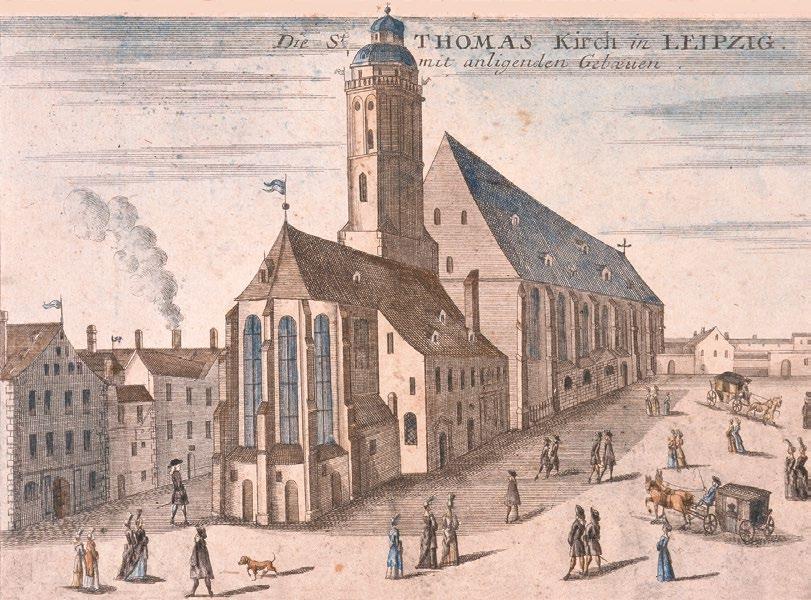
BWV 28, written for the Sunday after Christmas (30 December). Rather than drawing on the Bible readings of the day, Erdmann Neumeister’s text is primarily concerned with the turning of the year.
A beguiling concerto-like aria for soprano (No. 1) opens the cantata, its fashionable dance style reinforced by the antiphonal exchanges between instrumental groups. The soprano’s call to strike up a song of thanksgiving is answered by the choir in a stirring chorale (No. 2) that could not be more different: cast as a stile antico motet, its archaic character is reinforced through the use of cornetto and three trombones. Once again, the chorale melody is heard in long notes in the soprano, with the three lower parts weaving around each other in dense chromatic counterpoint. Two recitatives then appear in quick succession: the first, for bass (No. 3), directly sets words from the book of Jeremiah as
a song-like arioso, whilst the second, for tenor (No. 4), reflects on God’s many blessings. A delightful duet for alto and tenor (No. 5), highly imitative and Italianate in style, follows.
The final chorale, a four-part setting of Paul Eber’s New Year hymn ‘Helft mir Gotts Güte preisen’ (‘Help me praise God’s goodness’) is a moving and powerful prayer for God’s protection over the coming year. For Bach, the new year of 1726 would bring many personal and professional challenges, including the birth of one daughter and the death of another, not to mention the risky launch of his landmark series of keyboard publications, the ClavierÜbung. But the composition of sacred music, including the majority of the third cantata Jahrgang, remained fundamental to his work, as he sought to lift the hearts, minds and spirits of his audience. Exactly 300 years later, its power remains undiminished.
WIE SCHÖN LEUCHTET DER MORGENSTERN, BWV 1 (1725)
1. Choral
Wie schön leuchtet der Morgenstern voll Gnad und Wahrheit von dem Herrn, die süße Wurzel Jesse!
Du Sohn Davids aus Jakobs Stamm, mein König und mein Bräutigam, hast mir mein Herz besessen, lieblich, freundlich, schön und herrlich, groß und ehrlich, reich von Gaben, hoch und sehr prächtig erhaben.
2. Recitativo: Tenor
Du wahrer Gottes und Marien Sohn, du König derer Auserwählten, wie süß ist uns dies Lebenswort, nach dem die ersten Väter schon so Jahr’ als Tage zählten, das Gabriel mit Freuden dort in Bethlehem verheißen!
O Süßigkeit, o Himmelsbrot, das weder Grab, Gefahr, noch Tod aus unsern Herzen reißen.
3. Aria: Sopran
Erfüllet, ihr himmlischen göttlichen Flammen, die nach euch verlangende gläubige Brust!
Die Seelen empfinden die kräftigsten Triebe der brünstigsten Liebe und schmecken auf Erden die himmlische Lust.
4. Recitativo: Bass
Ein irdscher Glanz, ein leiblich Licht rührt meine Seele nicht; ein Freudenschein ist mir von Gott entstanden, denn ein vollkommnes Gut, des Heilands Leib und Blut,
For the Annunciation of the Blessed Virgin Mary
1. Chorale
How beautifully gleams the morning star, full of the Lord’s mercy and truth, the sweet root of Jesse!
Thou Son of David from Jacob’s line, my King and my Bridegroom, hast taken possession of my heart, sweet, friendly, beautiful and glorious, great and honest, rich in gifts, highly and most splendidly sublime.
2. Recitative: Tenor
Thou true Son of God and Mary, thou King of the elect, how sweet to us is this Word of Life, by which the earliest patriarchs both years and days did number, which Gabriel with gladness there in Bethlehem promised! O sweet delight, O bread of heaven that neither grave nor peril nor death can sunder from our hearts.
3. Aria: Soprano
Fill, ye heavenly divine flames, the faithful breast that longs for you! Our souls feel the strongest desires of most ardent love and savour on earth celestial joy.
4. Recitative: Bass
No earthly brilliance, no bodily light can ever stir my soul; a joyous ray has come to me from God, because a perfect treasure, the Saviour’s Body and Blood,
ist zur Erquickung da. So muss uns ja der überreiche Segen, der uns von Ewigkeit bestimmt und unser Glaube zu sich nimmt, zum Dank und Preis bewegen.
5. Aria: Tenor
Unser Mund und Ton der Saiten sollen dir für und für Dank und Opfer zubereiten. Herz und Sinnen sind erhoben, lebenslang mit Gesang, großer König, dich zu loben.
6. Choral
Wie bin ich doch so herzlich froh, dass mein Schatz ist das A und O, der Anfang und das Ende; er wird mich doch zu seinem Preis aufnehmen in das Paradeis, des klopf ich in die Hände. Amen! Amen!
Komm, du schöne Freudenkrone, bleib nicht lange, deiner wart ich mit Verlangen.
JESU CHRIST, WAHR’ MENSCH UND GOTT, BWV 127 (1725)
1. Choral
Herr Jesu Christ, wahr’ Mensch und Gott, der du littst Marter, Angst und Spott, für mich am Kreuz auch endlich starbst und mir deins Vaters Huld erwarbst, ich bitt durchs bittre Leiden dein: Du wollst mir Sünder gnädig sein.
2. Recitativo: Tenor
Wenn alles sich zur letzten Zeit entsetzet und wenn ein kalter Todesschweiß die schon erstarrten Glieder netzet, wenn meine Zunge nichts als nur durch
is there for our delight. Therefore the abundant bliss, destined for us since eternity, and which our faith now embraces, must move us to thanks and praise.
5. Aria: Tenor
Our mouths and the sound of strings shall prepare for Thee for ever and ever thanks and offerings.
Heart and spirits are uplifted all our life with song, great King, to praise Thee.
6. Chorale
How truly glad I am that my treasure is the A and O, the beginning and the end; He shall claim me as his prize, and take me in Paradise, for which I clap my hands.
Amen!
Amen!
Come, O lovely crown of joy, tarry not, I wait for Thee with longing.
For Estomihi, the First Sunday before Lent
1. Chorale
Lord Jesus Christ, true man and God, Thou, who didst bear torture, fear and scorn, finally to die for me upon the cross and win for me Thy father’s grace, by Thy bitter suffering I beg Thee: have mercy on me for all my sins.
2. Recitative: Tenor
When terror strikes at the final hour, and when death’s chill sweat moistens my already rigid limbs, when my tongue utters nothing but
Seufzer spricht und dieses Herze bricht: Genug, dass da der Glaube weiß, dass Jesus bei mir steht, der mit Geduld zu seinem Leiden geht und diesen schweren Weg auch mich geleitet und mir die Ruhe zubereitet.
3. Aria: Sopran
Die Seele ruht in Jesu Händen, wenn Erde diesen Leib bedeckt. Ach ruft mich bald, ihr Sterbeglocken, ich bin zum Sterben unerschrocken, weil mich mein Jesus wieder weckt.
4. Recitativo ed Aria: Bass
Wenn einstens die Posaunen schallen und wenn der Bau der Welt nebst denen Himmelsfesten zerschmettert wird zerfallen, so denke mein, mein Gott, im Besten; wenn sich dein Knecht einst vors Gerichte stellt, da die Gedanken sich verklagen, so wollest du allein, o Jesu, mein Fürsprecher sein und meiner Seele tröstlich sagen:
Fürwahr, fürwahr, euch sage ich: Wenn Himmel und Erde im Feuer vergehen, so soll doch ein Gläubiger ewig bestehen. Er wird nicht kommen ins Gericht und den Tod ewig schmecken nicht. Nur halte dich, mein Kind, an mich: Ich breche mit starker und helfender Hand des Todes gewaltig geschlossenes Band.
5. Choral
Ach, Herr, vergib all unsre Schuld, hilf, dass wir warten mit Geduld, bis unser Stündlein kömmt herbei, auch unser Glaub stets wacker sei, dein’m Wort zu trauen festiglich, bis wir einschlafen seliglich.
Paul Eber (1, 5); anon. (2-4)
sighs and this heart breaks: it is enough that faith knows that Jesus stands by me, who patiently draws near His passion and leads me too along the arduous path and prepares for me my resting place.
3. Aria: Soprano
My soul is at rest in the hands of Jesus, when earth shall cover this body. Ah, call me soon, O funeral bells, I am unafraid of dying, for my Jesus shall wake me again.
4. Recitative and Aria: Bass
When one day the trumpets shall sound, and when the world along with heaven’s foundation hall be shattered and sunk in ruin, then think on me, my God, in the best way possible; when one day Thy servant stands before the court, where even thoughts accuse me, then may it be Thy wish, O Jesus, to intercede for me and speak with comfort to my soul:
Verily, verily, I say to you: when heaven and earth perish in fire, believers shall survive forever. They shall not be judged and shall not taste eternal death. Just cling to me, my child: I break with my strong and helping hands the powerful bonds of encompassing death.
5. Chorale
Ah, Lord, forgive us all our guilt, help us with patience to wait until our hour of death shall come, and may our faith be ever firm, to trust steadfastly in Thy Word, till we fall asleep in bliss.
IHR WERDET WEINEN UND HEULEN, BWV 103 (1725)
1. Coro ed Arioso: Bass
Chor: Ihr werdet weinen und heulen, aber die Welt wird sich freuen. Bass: Ihr aber werdet traurig sein. Chor: Doch eure Traurigkeit soll in Freude verkehret werden.
2. Recitativo: Tenor
Wer sollte nicht in Klagen untergehn, wenn uns der Liebste wird entrissen? Der Seele Heil, die Zuflucht kranker Herzen acht’ nicht auf unsre Schmerzen.
3. Aria: Alt
Kein Arzt ist außer dir zu finden, ich suche durch ganz Gilead; wer heilt die Wunden meiner Sünden, weil man hier keinen Balsam hat? Verbirgst du dich, so muss ich sterben. Erbarme dich, ach, höre doch! Du suchest ja nicht mein Verderben, wohlan, so hofft mein Herze noch.
4. Recitativo: Alt
Du wirst mich nach der Angst auch wiederum erquicken; so will ich mich zu deiner Ankunft schicken, ich traue dem Verheißungswort, dass meine Traurigkeit in Freude soll verkehret werden.
5. Aria: Tenor
Erholet euch, betrübte Sinnen, ihr tut euch selber allzu weh. Lasst von dem traurigen Beginnen, eh ich in Tränen untergeh, mein Jesus lässt sich wieder sehen, o Freude, der nichts gleichen kann! Wie wohl ist mir dadurch geschehen, nimm, nimm mein Herz zum Opfer an!
6. Choral
Ich hab dich einen Augenblick, o liebes Kind, verlassen: Sieh aber, sieh, mit großem Glück
For Jubilate, the Third Sunday after Easter
1. Chorus and Arioso: Bass
Chorus: Ye shall weep and lament, but the world shall rejoice. Bass: And ye shall be sorrowful.
Chorus: But your sorrow shall be turned to joy.
2. Recitative: Tenor
Who would not founder in lamentation, when our beloved is snatched from us? The salvation of our soul, the refuge of sick hearts pays no heed to our sorrow.
3. Aria: Alto
No physician but Thee can be found, though I search through all Gilead; who shall heal the wounds of my transgressions, while there is no balm here for me?
If Thou dost hide, then I must perish. Have mercy, ah, give ear! For Thou dost not seek my destruction, my heart, then, shall still harbour hope.
4. Recitative: Alto
When my fear is past, Thou shalt again revive me; thus shall I make ready for Thy coming, I have trust in Thy promise, that my sadness shall be turned into joy.
5. Aria: Tenor
Recover now, O troubled feelings, you cause yourselves too much grief. Leave off your sorrowful beginnings, before I founder in tears, my Jesus shall appear again, O joy without compare! The happiness this causes me! Accept my heart as sacrifice!
6. Chorale
I have but for a little while forsaken you, dear child. Behold, though, with great happiness
und Trost ohn alle Maßen will ich dir schon die Freudenkron aufsetzen und verehren; dein kurzes Leid soll sich in Freud und ewig Wohl verkehren.
John 16:20 (1); Paul Gerhardt (6); Christiane Mariane von Ziegler (2-5)
BWV 28 (1725)
1. Aria: Sopran
Gottlob! nun geht das Jahr zu Ende, das neue rücket schon heran.
Gedenke, meine Seele, dran, wie viel dir deines Gottes Hände im alten Jahre Guts getan!
Stimm ihm ein frohes Danklied an; so wird er ferner dein gedenken und mehr zum neuen Jahre schenken.
2. Coro (Chorale)
Nun lob, mein Seel, den Herren, was in mir ist, den Namen sein!
Sein Wohltat tut er mehren, vergiss es nicht, o Herze mein!
Hat dir dein Sünd vergeben und heilt dein Schwachheit groß, errett’ dein armes Leben, nimmt dich in seinen Schoß. Mit reichem Trost beschüttet, verjüngt, dem Adler gleich. Der Kön’g schafft Recht, behütet, die leid’n in seinem Reich.
3. Recitativo ed Arioso: Bass
So spricht der Herr: Es soll mir eine Lust sein, dass ich ihnen Gutes tun soll, und ich will sie in diesem Lande pflanzen treulich, von ganzem Herzen und von ganzer Seele.
4. Recitativo: Tenor
Gott ist ein Quell, wo lauter
Güte fleußt; Gott ist ein Licht, wo lauter Gnade scheinet;
and comfort beyond all measure shall I put on you the crown of joy and worship you; your brief pain shall turn to joy and eternal well-being
1. Aria: Soprano
Praise God! The year now draws to a close, the New Year is approaching. Consider this, O my soul, the good that God’s hands wrought you in the year now past! Strike up for Him a joyous song of thanks, and He will continue to think of you and grant you more in this New Year.
2. Chorus (Chorale)
Now praise, my soul, the Lord, let all in me now praise His name! His goodness he increases, forget it not, O heart of mine! Your sins He has forgiven you, He heals your great weakness, saves your wretched life, takes you in His embrace. He pours His blessings on you, making you young, like the eagle. The King is just, and He protects those who suffer in His realm.
3. Chorus and Arioso: Bass
Thus saith the Lord: I will rejoice over them to do them good, and I will plant them in this land assuredly with my whole heart and with my whole soul.
4. Recitative: Tenor
God is a spring, where naught but kindness flows; God is a light, where naught but mercy shines;
Gott ist ein Schatz, der lauter Segen heißt; Gott ist ein Herr, der’s treu und herzlich meinet.
Wer ihn im Glauben liebt, in Liebe kindlich ehrt, sein Wort von Herzen hört und sich von bösen Wegen kehrt, dem gibt er sich mit allen Gaben. Wer Gott hat, der muss alles haben.
5. Aria (Duetto): Alt, Tenor
Gott hat uns im heurigen Jahre gesegnet, dass Wohltun und Wohlsein einander begegnet.
Wir loben ihn herzlich und bitten darneben, er woll’ auch ein glückliches neues Jahr geben.
Wir hoffen’s von seiner beharrlichen Güte und preisen’s im Voraus mit dankbar’m Gemüte.
6. Choral
All solch dein Güt wir preisen, Vater ins Himmels Thron, die du uns tust beweisen durch Christum, deinen Sohn, und bitten ferner dich: Gib uns ein friedsam Jahre, für allem Leid bewahre und nähr uns mildiglich.
Erdmann Neumeister (1, 4, 5);
Johann Gramann (2);
Jeremiah 32:41 (3); Paul Eber (6)
God is a treasure, which naught but blessing gives; God is a Lord with true and kind intent.
Who loves Him in faith, honours Him in childlike love, takes His word to heart and turns from the path of evil, to him He gives Himself abundantly. He who has God has everything.
5. Aria (Duet): Alto, Tenor
God has blessed us in the past year, with good deeds and prosperity alike.
We praise Him from our hearts, and beseech Him that He may also grant us a happy New Year.
We hope for this of His constant goodness and praise Him already with thankful hearts.
6. Chorale
We praise Thee for all Thy kindness, Father on heaven’s throne, that Thou showest us through Christ, Thy Son, and we beseech Thee now as well to grant us a peaceful year, to protect us from all sorrow and gently to sustain us.
English translations by Richard Stokes from J. S. Bach: The Complete Cantatas, 1999, Scarecrow Press, reproduced with permission.
Conductor
Since founding Bach Collegium Japan in 1990, Masaaki Suzuki has established himself as a leading authority on the works of J. S. Bach. He has remained their Music Director ever since, taking them regularly to major venues and festivals in Europe and the USA, recording the complete cycle of Bach’s Sacred Cantatas and building up an outstanding reputation for the expressive refinement and truth of his performances.
In addition to working with renowned period ensembles, such as Collegium Vocale Gent, Orchestra of the Age of Enlightenment and Philharmonia Baroque Orchestra, Suzuki is invited to conduct repertoires as diverse as Brahms, Britten, Fauré, Mahler, Mendelssohn, Dvořák and Stravinsky, with orchestras such as New York Philharmonic, San Francisco Symphony Orchestra, Los Angeles Philharmonic, Orchestre Symphonique de Montréal, hr-Sinfonieorchester, Philharmonia Orchestra, Deutsches Symphonie-Orchester Berlin, Mozarteum Orchester Salzburg, Gewandhausorchester Leipzig, Bavarian Radio, Danish National Radio, Gothenburg Symphony, Orchestre Philharmonique de Radio France, and Yomiuri Nippon Symphony Orchestra.
This 2024/25 season includes his return to Orchestre de Chambre de Paris and Kyoto Symphony Orchestra, and his debut with The Philadelphia Orchestra, New Zealand Symphony Orchestra and Schola Cantorum Basiliensis, among
others. Suzuki is also returning to Lahti Symphony Orchestra, Orquesta Sinfónica de Bilbao and Orquestra Sinfònica do Estado de São Paulo.
Suzuki’s impressive discography on the BIS label, featuring all Bach’s major choral works as well as complete works for harpsichord, has brought him many critical plaudits. The Times writes, “it would take an iron bar not to be moved by his crispness, sobriety and spiritual vigour”. 2018 marked the triumphant conclusion of Bach Collegium Japan’s epic recording of the complete sacred and secular cantatas initiated in 1995 and comprising sixty-five volumes. The ensemble has also recently recorded the Gramophone-awarded Bach’s St. John’s Passion and St. Matthew’s Passion.
He has previously been invited with Bach Collegium Japan to the BBC Proms festival, and in June 2023 participated as one of three ensembles in the cantata cycle at Bachfest Leipzig, where they also gave a critically acclaimed performance of Mendelssohn’s Elijah; their busy touring schedule also took them to the USA performing at venues including the Alice Tully Hall, New York, the Davies Symphony Hall, San Francisco, and several tours across Europe. Suzuki has also toured in Europe with Orchestra of the Age of Enlightenment and Philharmonia Orchestra.
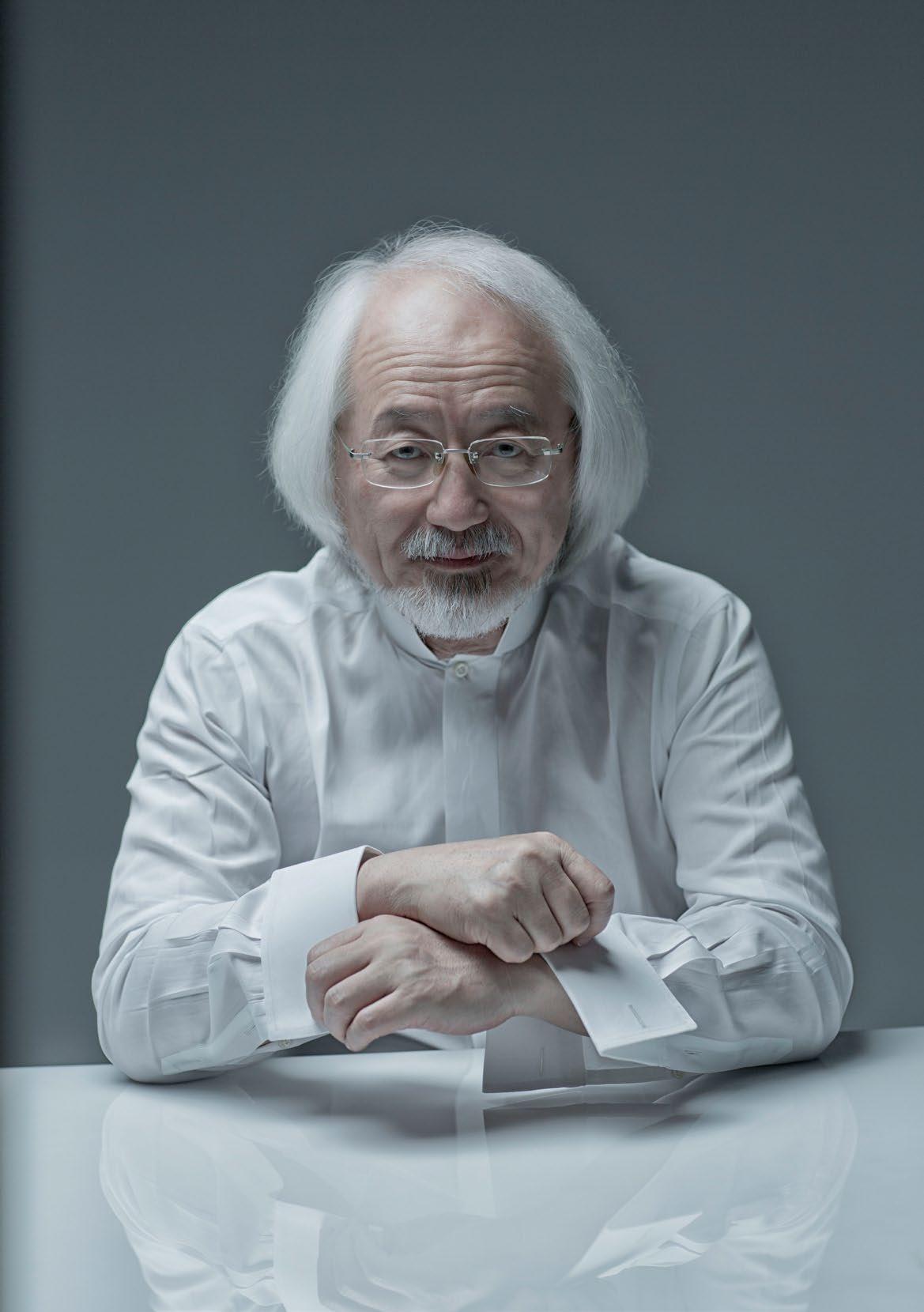

soprano
Equally at home on the concert and opera stages, Carolyn Sampson has enjoyed notable successes in the UK, throughout Europe and the rest of the world.
Last season marked an incredible achievement for Carolyn as she celebrated her recording legacy with the release of her 100th album as a featured solo artist. In 2024 she was awarded an OBE in the King’s New Year Honours, was elected an Honorary Member of the Royal Academy of Music and was the winner of the Gramophone Artist of the Year Award.
On the opera stage she has appeared with English National Opera, Glyndebourne Festival Opera, Scottish Opera and Opéra de Paris, amongst others, and she regularly performs at the BBC Proms and with orchestras including the Bach Collegium Japan, Royal Concertgebouw Orchestra, Rotterdam Philharmonic, Vienna Symphony Orchestra and with numerous orchestras in the UK & USA.
A consummate recitalist, Carolyn performs regularly at the Wigmore Hall and has given recitals at the Amsterdam Concertgebouw, Saintes and Aldeburgh Festivals, Barcelona, Freiburg, Oper Frankfurt, Pierre Boulez Saal Berlin, Vienna Konzerthaus, Carnegie Hall and on tour in Japan.
This season includes Haydn Die Schöpfung/Creation, with both the Orchestre de Chambre de Paris under Masato Suzuki and the CBSO under Kazuki Yamada, and another European tour with Bach Collegium Japan.

mezzo-soprano
Singing with ‘grace and beauty’ (The Telegraph), Rebecca Leggett is making a name for herself in the field of early music.
Since joining the 11th edition of Les Arts Florissants’ ‘Le Jardin des Voix’ scheme, Rebecca has toured in the ensemble’s production of Purcell’s The Fairy Queen with William Christie; venues include Teatro alla Scala, the Lincoln Center NYC and the Royal Albert Hall for the BBC Proms 2024. Further concerts with the ensemble include Christie’s 80th birthday tour earlier this year, and touring as Piacere in Handel’s Il Trionfo del Tempo e del Disinganno in July 2025.
A ‘Rising Star’ with the Orchestra of the Age of Enlightenment, Rebecca recently made her debut with Monteverdi Choir & Orchestras under the baton of Christophe Rousset. She has appeared with ensembles such as Arcangelo, The Sixteen, London Handel Players, Instruments of Time and Truth, City of London Sinfonia, and the Oxford Philharmonic Orchestra. She was a finalist for the Kathleen Ferrier Award in 2023, and an Emerging Artist at the Oxford Lieder Festival in 2022.
On the opera stage, Rebecca has sung at Teatro Maggio Fiorentino and Glyndebourne (Britten’s The Turn of the Screw), Blackheath Halls Opera (John Blows’ Venus and Adonis) and Collegium Music Bergen (Handel’s Theodora).

British tenor Guy Cutting is recognised internationally for his compelling performances and refined musicianship, with a particular reputation in the music of J.S. Bach. A regular soloist with Collegium Vocale Gent and conductor Philippe Herreweghe, he has performed across Europe’s leading concert halls and festivals including La Scala Milan, the BBC Proms and the Philharmonie, Berlin.
Cutting is in great demand as Evangelist in Bach’s St Matthew and St John Passions and Christmas Oratorio, working with ensembles such as the Orchestra of the Age of Enlightenment, the Dunedin Consort and the Orchestra of the 18th Century. His interpretations are noted for their expressive phrasing, technical fluency and deep understanding of the text. He has contributed extensively to the Netherlands Bach Society All of Bach video series.
While Bach remains at the heart of his repertoire, Cutting also performs a wide range of music from the early Baroque to the 21st century appearing with Royal Concertgebouw Orchestra, Tonhalle Orchestra Zurich and the Bergen Philharmonic. He will shortly make his opera début singing Don Ottavio in Don Giovanni at the Confidencen Festival in Sweden. Guy was a Choral Scholar at New College, Oxford, the inaugural recipient of the American Bach Soloists’ Jeffrey Thomas Award and a Rising Star of the Enlightenment.

Born in 1990 in Munich, bass-baritone Matthias Winckhler studied at the Bavarian Vocal Academy and Salzburg Mozarteum University under Andreas Macco and Wolfgang Holzmair. He refined his skills in masterclasses with Matthias Goerne, Graham Johnson, Christa Ludwig, Bejun Mehta, Peter Schreier, and others. A recipient of scholarships from the Walter & Charlotte Hamel Foundation and the Walter Kaminsky Foundation, he has earned multiple awards, including First Prize at the 2014 Salzburg International Mozart Competition and the Trude Eipperle Rieger Prize in 2017.
Winckhler collaborates with renowned conductors such as Giovanni Antonini, Vasily Petrenko, Jordi Savall, and Masaaki Suzuki, performing with leading ensembles like the Vienna Philharmonic, Akademie für Alte Musik Berlin, Bach Collegium Japan, and the Oslo Philharmonic. His festival appearances include the Salzburg Festival, Kissinger Sommer, and Leipzig Bachfest.
From 2015 to 2018, he was a soloist at Hannover State Opera, performing roles such as Count Almaviva (Le Nozze di Figaro), Papageno (Die Zauberflöte), Albert (Werther), and Belcore (L’elisir d’amore).
A dedicated Lied interpreter, Winckhler frequently collaborates with pianists like Marcelo Amaral and Jan-Philip Schulze. He is also active in contemporary music, working with composers such as Nikolaus Brass and Manfred Trojahn, premiering several new works.
For over 60 years the Monteverdi Choir has been recognised as one of the greatest and most influential choirs in the world. Through a combination of consummate technique and historically-informed performance practice, the Choir constantly strives to bring fresh perspectives, immediacy and drama to its performances.
The recipient of many awards, the Monteverdi Choir was named ‘Best Choir’ at the 2024 Oper! Awards, with the jury noting that: “At festivals, on concert tours and in their numerous recordings, this is an ensemble whose quality will always leave the listener speechless.”
Fresh from celebrating its 60th anniversary in 2024, the Choir has a full 2025 with a range of concerts and projects in support of MCO’s expansion of its repertoire and conductor collaborations.
The Choir is playing a crucial role in the opening concert of this year’s Edinburgh International Festival, performing John Tavener’s monumental The Veil of The Temple. As the central and only professional choir performing, the Choir is also providing soloists and joining other choirs throughout the eight-hour performance. The Choir previously commissioned John Tavener’s The World is Burning in 1993 to celebrate its 30th anniversary.
The Monteverdi Choir will be prepared for this epic performance by Jonathan
Sells, who was appointed Choir Director in March 2025. He conducts the Choir and the English Baroque Soloists two days later at the Usher Hall for ‘Sing to the Lord a New Song’, featuring a selection of works by Purcell, Bach and Handel (including Dixit Dominus). As Choir Director, Sells will work closely with the artistic planning team and have general oversight of the Choir, as well as conducting concerts throughout each season.
Other highlights in 2025 include Mozart with Pablo Heras-Casado, semi-staged Rossini with Jakob Lehmann, and Handel with Christophe Rousset. On Good Friday 2025, the MCO’s own recording label, Soli Deo Gloria, released its first new recording since before the global pandemic with an album of Bruckner and Gesualdo motets recorded live in concert in October 2024, conducted by Jonathan Sells. In September, an album will be released of Charpentier conducted by Christophe Rousset that was toured across Europe last December.
The Choir’s anniversary season in 2024 opened with three concerts at Amsterdam’s Concertgebouw conducted by Dinis Sousa. These performances were followed by Handel’s Israel in Egypt conducted by Peter Whelan in London and across European; Beethoven’s Mass in C major and Symphony No. 9 in London and Paris; and Bach’s sacred motets in London and Leipzig conducted by Jonathan Sells, who then returned to conduct the Choir in performances of Bruckner and Gesualdo motets in Ely, Oxford and London.
Founded in 1964 by John Eliot Gardiner, the Monteverdi Choir has released over 150 recordings and won numerous prizes. In 2023, the Choir and English Baroque were honoured to perform at the Coronation of HM The King, with The Telegraph proclaiming “if the Monteverdi Choir isn’t singing when I get to the gates of Heaven, I want my money back.”
The Monteverdi Choir has dominated the choral scene worldwide for more than 50 years.” The Guardian
Two hours of musical delight...the Monteverdi Choir displayed such effortless virtuosity...leaving the audience in awe.” Musica (Italy)
St Martin-in-the-Fields, London 19 June 2025
Soprano
Carolyn Sampson*
Rachel Allen
Lucy Knight
Rebecca Lea
Theano Papadaki
Daisy Walford
Alto
Rebecca Leggett*
Francesca Biliotti
Matthias Dähling
Nathan Mercieca
Tenor
Guy Cutting*
Oscar Golden-Lee
Tom Kelly
Gareth Treseder
Bass
Matthias Winckhler*
Tristan Hambleton
Johnny Herford
Jonathan Howard
Intricate and detailed throughout…it was brilliant.” Die Presse
For over 40 years The English Baroque Soloists has been one of the most innovative period-instrument ensembles and has consistently challenged the preconceptions of audiences around the world. Equally at home in chamber, symphonic and operatic performances, its distinctively warm and incisive playing is instantly recognisable in music ranging from Monteverdi to Mozart. The ensemble has performed at many of the world’s most prestigious venues, including Milan’s Teatro alla Scala, the Concertgebouw in Amsterdam and the Sydney Opera House.
The EBS’s current season has seen them expand their repertoire and conductor collaborations, highlighting a drive for new creative challenges with a year that includes Mozart with Marc Minkowski, semi-staged Rossini with Jakob Lehmann, and Handel with Christophe Rousset.
The EBS and the Monteverdi Choir are appearing at the 2025 Edinburgh International Festival with ‘Sing to the Lord a New Song’, which will feature a selection of works by Purcell, Bach and Handel (including Dixit Dominus), conducted by Jonathan Sells.
In December 2024, the ensemble performed Bach and Charpentier with the Monteverdi Choir on a European tour to La Scala Milan, Alte Oper Frankfurt, Elbphilharmonie Hamburg and St Martin-in-the-Fields, its London home. The tour was conducted by
renowned French Baroque specialist Christophe Rousset, making his MCO debut. These performances were universally greeted with praise, with the Guardian describing it as “joyous and immaculate,” while Operawire noted “a fresh sense of artistic renewal”.
Also in 2024, the EBS joined the Monteverdi Choir for performances of Handel’s oratorio Israel in Egypt, conducted by Peter Whelan. This programme toured to the Palau de la Música Barcelona, Philharmonie Luxembourg, Chapelle Royale Château de Versailles, Elbphilharmonie Hamburg and Haus für Mozart, Salzburg.
In 2023, the EBS and the Monteverdi Choir, conducted by Dinis Sousa, performed Bach’s Mass in B minor and Handel’s pastoral ode L’Allegro, il Penseroso ed il Moderato on an
American tour, following its European tour of Bach’s monumental work. Also in 2023, the EBS and the Monteverdi Choir were honoured to perform at the Coronation of HM The King.
The ensemble famously took part in the iconic Bach Cantata Pilgrimage in 2000 alongside the Monteverdi Choir, performing all of Bach’s sacred cantatas throughout Europe, and recorded for Soli Deo Gloria, the MCO’s own label. They also made the earliest recording of Mozart’s complete piano concertos on period instruments, as well as his greatest operas for Deutsche Grammophon.
Founded in 1978 by John Eliot Gardiner, the EBS has also participated in major opera productions alongside the Monteverdi Choir in works by Handel, Purcell and Monteverdi.
The strings created a beautifully earthy sound.” New York Times
The orchestra played dextrously… Every detail could be heard.” The Times
St Martin-in-the-Fields, London
19 June 2025
Violin I
Madeleine Easton
Naomi Burrell
Sarah Bealby-Wright
Mark Seow
Oliver Cave
Violin II
Jorge Jiminez
Conor Gricmanis
Flora Curzon
Anna Jane Lester
Viola
Oscar Holch
Elitsa Bogdanova
George White
Thomas Kettle
Cello
Felix Knecht
George Ross
Pedro da Silva
Jacob Garside
Double Bass
Rosie Moon
Recorder
Tabea Debus
Elizabeth Walker
Oboe
Mark Baigent
Cait Walker
Geoff Coates
Bassoon Fergus Butt
Trumpet
Russell Gilmore
Horn
Lionel Pointet
Joseph Walters
Sackbut
Miguel Tantos
Sevillano
Martyn Sanderson
James Buckle
Organ
Satoko Doi-Luck
The Monteverdi Apprentices Programme is a training scheme for young musicians that seeks to bridge the gap between higher education and a professional, freelance music career. By crafting a supportive learning environment for talented young artists, providing rewarding performance opportunities alongside our ensembles, and exposing them to coaching from experts in a range of fields, the Monteverdi Choir and Orchestras (MCO) aim to nurture the next generation of musical talent.
The Apprentices take part in workshops and masterclasses with a focus on historically-informed performance practices. Previously, these have been led by industry-leading singers and coaches including Jean-Paul Fouchécourt, Sophie Daneman and Richard Stokes. Each Apprentice is also matched to an experienced member of the Monteverdi Choir who acts as a mentor, offering them tailored artistic and practical support, providing invaluable holistic advice, guiding them through the practicalities of preparing for projects, and helping them to adjust and integrate into the wider ensemble whilst still encouraging their personal development.
Monteverdi Apprentices are also given the opportunity to perform with our world-class ensembles, joining the Monteverdi Choir, English Baroque Soloists and Orchestre Révolutionnaire et Romantique for concerts both in the UK and overseas.
Our aim is to expand their musical education, to help prepare them for future challenges, and to allow them to gain unrivalled experience of the working practices of an internationally renowned ensemble in a safe and supportive environment. By the end of each programme, we expect to have equipped these young musicians with the skills to be able to work as professionals with MCO and other similar organisations worldwide. Now in its 18th year, the programme has over 90 alumni, and many prior Apprentices still perform regularly with the Monteverdi ensembles.
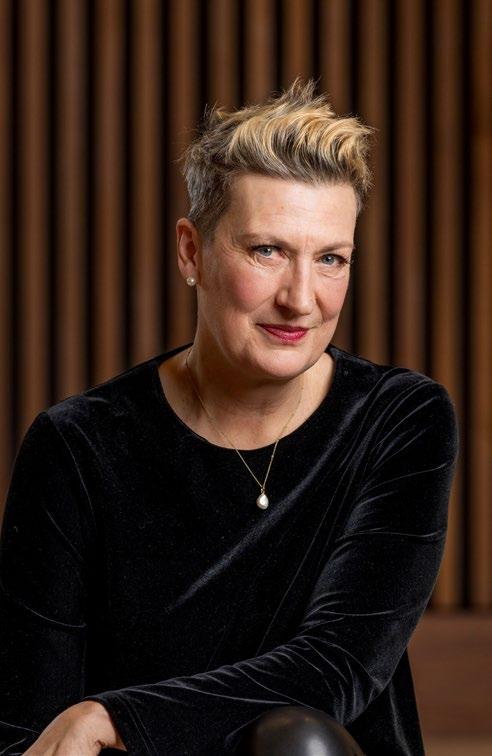

We are delighted to announce that internationally acclaimed soloists Dame Sarah Connolly and Mark Padmore have become Ambassadors for the Monteverdi Apprentices Programme.
Both Sarah and Mark have a long association with the Monteverdi Choir, and both share our deep commitment to nurturing the next generation of vocal talent. Each brings a wealth of experience, a passion for ensemble singing and a profound understanding of vocal artistry, stylistic versatility and the demands of a modern singing career. As inspirational role models and experienced mentors, they will offer invaluable guidance to the Apprentices,
drawing on their wide-ranging professional insight. The announcement of their new roles coincides with the unveiling of nine exceptional young singers for the upcoming season, following a record number of applications. More details about our 2025/26 Apprentices can be found on our website (monteverdi.org.uk).
Monteverdi Choir & Orchestras’ (MCO) mission is to bring fresh perspectives, immediacy and drama to historically inspired musical performances around the world. MCO is made up of three internationally-renowned ensembles that lead the field of period performance: the Monteverdi Choir, English Baroque Soloists and Orchestre Révolutionnaire et Romantique. Performing regularly in London concert venues, as well as touring worldwide, MCO is in its 61st year of delivering outstanding performances and recordings to global critical acclaim.
As a registered charity with no public subsidy, the Monteverdi Choir and Orchestras rely on the generosity of our supporters to continue planning our ambitious, historically-informed artistic programme. This support allows us to deliver projects without compromising on artistic quality or integrity, to share our concerts with music lovers around the world through top-quality film and audio content, and helps us to nurture and develop the next generation of musical talent.

Our membership scheme starts from £250 per year. Members enjoy a range of benefits including a personalised priority booking service for all our concerts, monthly newsletters, and invitations to post-concert receptions. At higher levels, additional benefits include invitations to exclusive open rehearsals and backstage access after our performances.
By supporting our charity at this highest level, you will contribute substantially towards our landmark projects, allow us to perform regularly in our London home at St Martin-inthe-Fields, and share our music globally via our filmed concerts.
We can offer creative and collaborative sponsorship packages that enable you to align your business with our work. There are opportunities to sponsor individual performances, or an entire season of concerts at our London home, St Martin-in-the-Fields.
By choosing to leave a Legacy Gift to the Monteverdi Choir & Orchestras, you will play a crucial role in ensuring that the performers and listeners of the future will continue to be enthralled by the power of our music-making.
Our American Friends play a valuable part in supporting and championing the work of the Monteverdi ensembles both in the US and beyond. The American Friends of the Monteverdi Choir & Orchestras, Inc is a registered 501(c)(3) organisation and donations to it are tax-deductible for US taxpayers to the extent allowed by law. EIN:31-1651106.
If you wish to find out more about supporting MCO please get in touch. On our website, you will find the facility to make a donation (which we warmly welcome at any level), purchase one of our memberships, or treat a friend via a Gift Membership. If you would like to discuss becoming a Benefactor, or how your organisation could partner with us, please contact us to arrange a conversation with our General Director.
development@monteverdi.org.uk www.monteverdi.co.uk/support-us
The Monteverdi Choir & Orchestras gratefully acknowledges the generous support of the following individuals, organisations and Trusts & Foundations:
PATRON
HM The King
PRESIDENT
Carol Grigor CBE
PRINCIPAL FUNDER
Dunard Fund
BENEFACTORS
Michael Beverley
David & Sandra Brierwood
Christian & Myrto Rochat
Sir David & Lady Walker
David Best
Lord & Lady Burns
Morny Davison
Lord & Lady Deben
Sir Vernon Ellis
Andrey Kidel
William Lock
Sebastian & Flora Lyon
Francis Norton
Yoshi Onodera
Helen & John Skinner
Clare Woodman CBE
Anonymous (2)
Lady Virginia Fraser
Sir Stephen Gomersall
Gordon Gullan
Stephen & Victoria Swift
Anonymous (1)
Julia & Martin Albrecht
Geoffrey Barnett
Donald & Corrine Brydon
Rosemary Chadder
Peter & Stephanie Chapman
Sarah & Mike Cuthbert
Tony Hales CBE
Yi-Peng Li
Lady Nixon
Mollie Norwich
Stefan Paetke
Nicholas & Christylle Phillips
Professor Richard Portes CBE FBA
Anthony C. Shoults
Professor John Smyth
Anonymous (2)
Tania Bader
Donald D. Campbell
Vanessa Claypole
Dr Carol Cobb
Steve Edge
Jonathan Edwards
Lady Egremont
Nigel Gibson
Jenny Hill
Robert Moreland
Mary Pinnell
Daan Posthuma
Meghan Purvis
Anne Reyersbach
Thomas Richter
Dr Paul A. Sackin
Steven & Olivia Schaefer
Christopher J. H. Thornhill
Jenny & John Wiggins
Anonymous (2)
Morgan Stanley
Dunard Fund
King Charles III Charitable Fund
Garfield Weston Foundation
The David and Claudia Harding Foundation
Mrs F B Laurence’s Charitable Trust
The Rainbow Dickinson Trust
The Thistle Trust
Roger Chadder
Peter J. Chapman
Ian Hay Davison CBE
Sir Henry Keswick
Judith McCartin Scheide
Nicholas Snowman OBE
Geoffrey Taunton
The Estate of Donald Gorman
The Estate of Howard Hodgkin
The Estate of Kevin Lavery
The Negaunee Foundation
William Dudley
Neil Graham
David Kay
Seth Levi
Jai Shekhawat
Rory Walck
With grateful thanks to those who wish to remain anonymous and to the other individuals who give regular donations in support of our work.
Dr Rosa Solinas General Director
Martin Wheeler Finance & Administration Manager
James Halliday Artistic Advisor & Librarian
Matthew Knight Artistic Planning Manager
Janet Marsden Head of Concerts & Tours
David Kay Philanthropy Manager
Charlotte Walker Development Assistant
Katie Care Tour Manager
Orlando Jones Administrator
Philip Turbett Orchestra Fixer
Matthew Muller Stage Manager
Premier Comms PR & media relations
Big Man Consultancy Instrument Transport
Robin Jennings
Keyboard Technician (keyboards provided by Jennings Organs)
Sir David Walker (Chairman)
Christian Rochat (Deputy Chairman)
David Best
Lady Deben
Nicholas Eldred
Virginia Fraser
Sir Stephen Gomersall
Diana Houghton
Andrey Kidel
Francis Norton
Caz Weller Knight
Level 12, 20 Bank Street, Canary Wharf, London E14 4AD, UK info@monteverdi.org.uk
Registered in England & Wales Company No. 01277513
Charity No. 272279
SIGN UP FOR OUR NEWSLETTER
What’s On | News | Reviews | Media
Scan the QR code or visit: www.monteverdi.co.uk/ pages/newsletter
LISTEN TO MCO
Recordings | Videos | Performances | Podcasts

Scan the Spotify link to listen to the Monteverdi Choir, or buy our recordings at: shop.monteverdi.co.uk
FOLLOW US ON SOCIAL MEDIA

Monteverdi Choir
English Baroque Soloists
Jonathan Sells – conductor

Thursday 4 September 2025, 7.30pm
Old Royal Naval College Greenwich, UK
monteverdi.co.uk

Friday 19 September 2025, 7.30pm St Martin-in-the-Fields London, UK
Monteverdi Choir
Orchestre Révolutionnaire et Romantique
Pablo Heras-Casado – conductor
